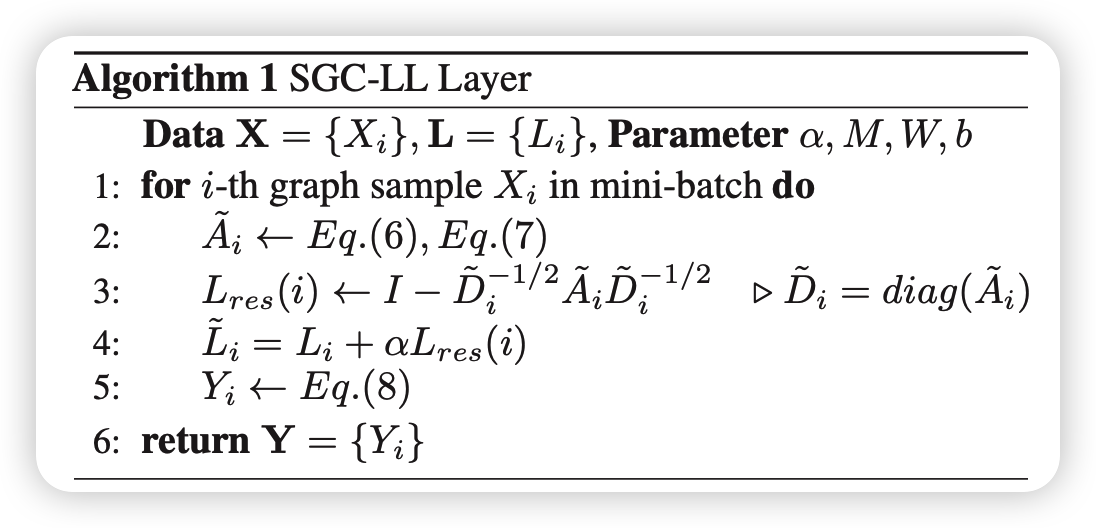Adaptive GCN (2018, 406)
Contents
- Abstract
- Introduction
- Method
- SGC-LL Layer
- AGCN Network
Abstract
GCN : generalization of classical CNNs to handle graph data
Most of data’s graph structures varies in both data size & connectivity
This paper proposes…
\(\rightarrow\) a generalized & flexible graph CNN, taking data of arbitrary graph structure as input
-
task-driven adaptive graph
-
to efficiently learn the graph, a distance metric learning is proposed
1. Introduction
previous GCN : inital graph structure is FIXED
Bottleneck of current GCN :
- restrict graph degree
- require identical graph structure shared among inputs
-
fixed graph ( without training )
- incapable of learning from topological structure
Proposal
propose a novel spectral GCN, that feed on original data of DIVERSE graph structures
train a “residual graph”, to discover the residual sub-structures that the intrinsic graph never includes
Direct leraning of Laplacian : \(O(N^2)\)
But, if we use supervised metric learning with Mahalanobis distance,
\(\rightarrow\) can reduce to \(O(d^2)\) ( or even \(O(d)\), assuming metric parameters are shared across samples )
Also, propose a re-parameterization on the feature domain
Summary
- construct unique graph Laplacian
- unique residual Laplacian matrix
- added on the initial adjacency matrix
- Learn a distance metric for graph update
- topological structures of graph are updated
- Feature embedding in convolution
- Accept flexible graph inputs
2. Method
(1) SGC-LL Layer
parameterize the distance metrics
SGC-LL Layer ( Specral Graph Convolution layer with Graph Laplacian Learning )
- convolution with \(K\)-localized spectral filter, constructed on adaptive graph
a) Learning Graph Laplacian
Normalized graph Laplacian matrix :
-
\(L=I-D^{-1 / 2} A D^{-1 / 2}\).
- determines node-wise connectivity and the degree of vertices
- knowing \(L\) = knowing topological structure of \(G\)
Eigen decomposition
- Eigen vectors \(U\), formed by \(\left\{u_{s}\right\}_{s=0}^{N-1}, N\)
- use \(U\) as graph Fourier basis..
- graph Laplacian : diagonalized as \(L=U \Lambda U^{T}\)
- graph Fourier Transform : \(\hat{x}=U^{T} x\)
- spectral representation of graph topologi is \(\Lambda\)
- spectral filter : \(g_{\theta}(\Lambda)\)
- generates customized convolution kernel
- spectral filter : \(g_{\theta}(\Lambda)\)
( Previous Works )
Formulate \(g_{\theta}(\Lambda)\) as polynomial :
- \[g_{\theta}(\Lambda)=\sum_{k=0}^{K-1} \theta_{k} \Lambda^{k}\]
-
\(K\) localized kernel
-
parameterization by \(\theta_{k}\) …
\(\rightarrow\) restricts the flexibility of kernel
propose a NEW SPECTRAL FILTER
- Parameterizes \(L\), instead of \(\theta_{k}\)
- \(g_{\theta}(\Lambda)=\sum_{k=0}^{K-1}(\mathcal{F}(L, X, \Gamma))^{k}\).
- \(\mathcal{F}(L, X, \Gamma)\) outputs the spectrum of updated \(\tilde{L}\)
- SGC-LL layer :
- \(Y=U g_{\theta}(\Lambda) U^{T} X=U \sum_{k=0}^{K-1}(\mathcal{F}(L, X, \Gamma))^{k} U^{T} X\).
b) Training Metric for Graph Update
Generalized Mahalanobis distance :
- \(\mathbb{D}\left(x_{i}, x_{j}\right)=\sqrt{\left(x_{i}-x_{j}\right)^{T} M\left(x_{i}-x_{j}\right)}\).
with distance, calculate Gaussian kernel
- \(\mathbb{G}_{x_{i}, x_{j}}=\exp \left(-\mathbb{D}\left(x_{i}, x_{j}\right) /\left(2 \sigma^{2}\right)\right)\).
Normalize \(\mathbb{G}\) \(\rightarrow\) obtain DENSE adjacency matrix \(\hat{A}\)
c) Re-parameterization on feature Transform
CNN : output feature of conv layer = sum of all feature maps
However, on GCN, it is not explainable to create / train separate topological structure for different vertext features on the same graph
\(\rightarrow\) introduce a transform matrix & bias vector
\(Y=\left(U g_{\theta}(\Lambda) U^{T} X\right) W+b\).
d) Residual Graph Laplacian
no prior knowledge on distance metric….
in order to accelerate training…
assume that the optimal graph Laplacian is a “small shifting from the originla graph Laplacian”
- \(\hat{L}=L+\alpha L_{r e s}\).
(2) AGCN Network

SGC-LL layer + graph max pooling + graph gather
-
graph max pooling : feature-wise
- \(\hat{x}_{v}(j)=\max \left(\left\{x_{v}(j), x_{i}(j), \forall i \in N(v)\right\}\right)\).
-
graph gather
- element-wise sums up all the vertex feature vectors, as the representaiton of grpah data
